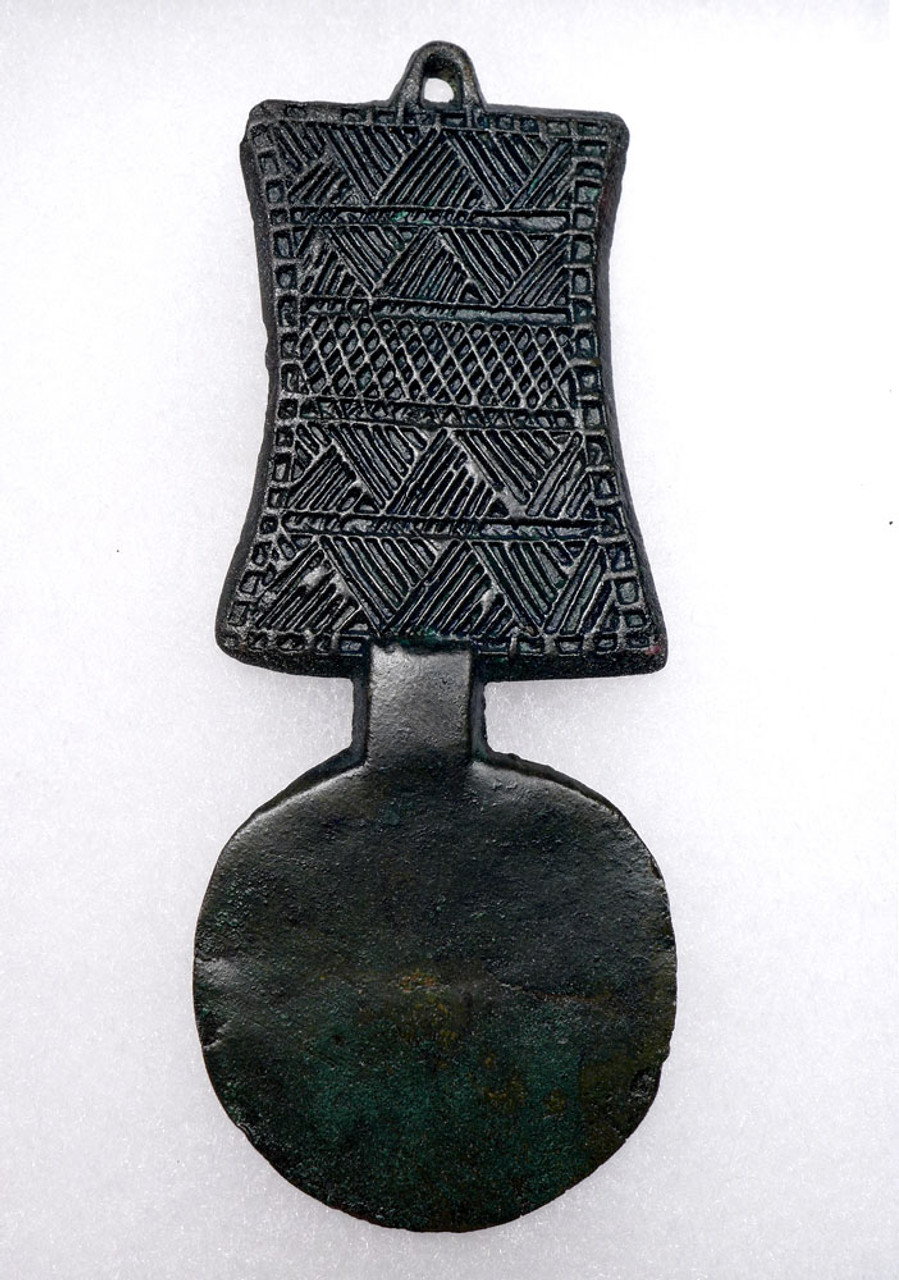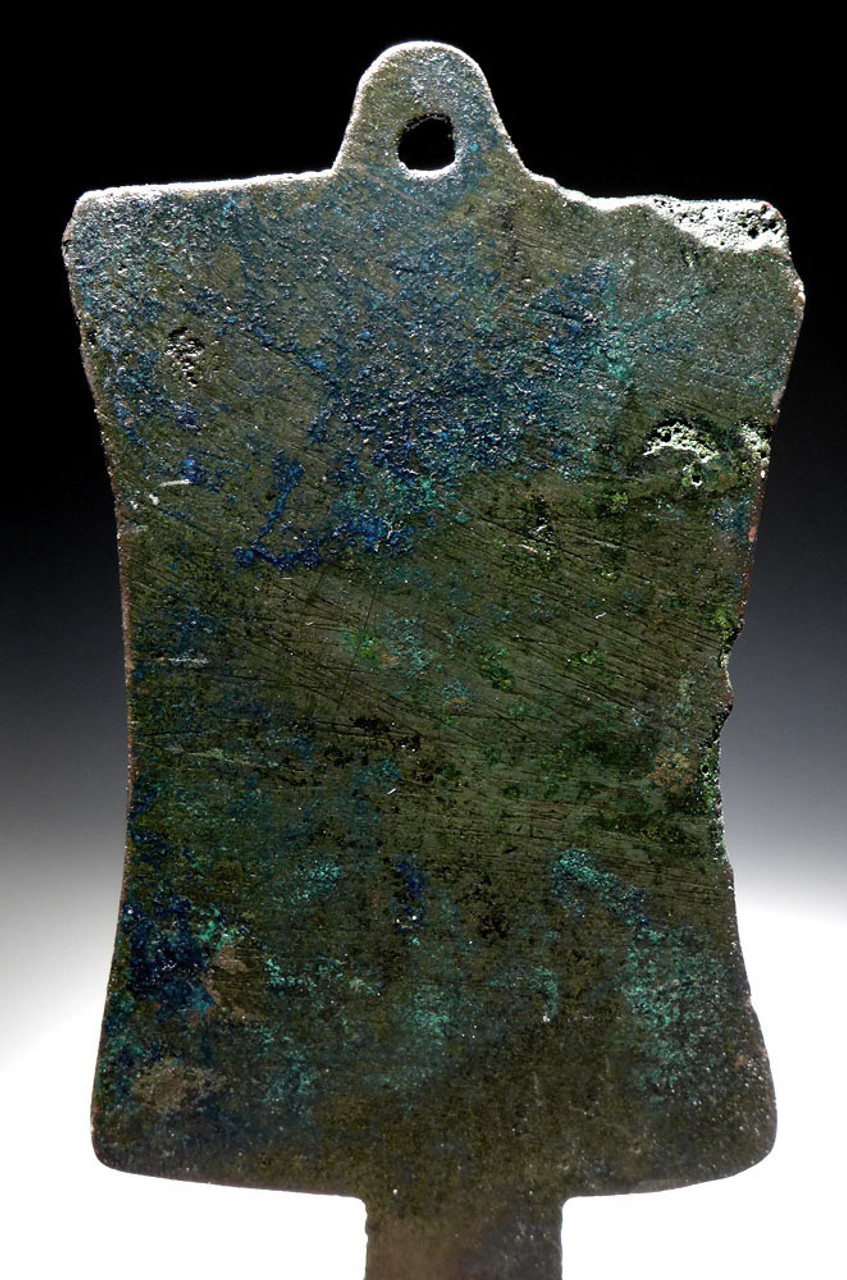Product Description
SEE MORE ANCIENT NEAR EASTERN ARTIFACTS
This is a genuine EXTREMELY RARE and EXQUISITE bronze ancient tribal clan badge from the nomadic horseback warriors of the ancient Near East . It is the most elaborate and intricately designed example we have seen of all published types. Clan badge pendants like these would have been attached to warrior's clothing and to the horse armor and saddle blankets. They were a way of identifying with a specific clan or tribe in ancient times, and their symbolism helped to identify each other from friend or foe, in times of heated combat. Various types of ancient art of the Near East can be seen with horseback warriors riding horses clothed in cloaks and saddle blankets decorated with these abstract clan badge symbols. Most were made of hammered sheet metal and have rarely survived but this specimen is made from cast bronze, hence its incredible preservation and perfect, intact condition!
Images of these badges can be seen on ancient rock carvings in Iran. See the Men-at-Arms publication "Rome's Enemies (3) by Peter Wilcox, for more references and images.
Many ancient Near Eastern clan tribal badges featured a circular design in their appearance but this example takes it to the extreme with a very fine basket woven design of alternating ridges in a complex shield-shaped rectangle just above the circle. Its ancient origin was one of being made in the lost-wax casting method. The very fine detail to the face would have required the most skilled craftsperson to be able to carefully carve such fine, linear detail. The surface shows colorful malachite and azurite mineral encrustations to attest to its age. As an incredible bonus to its authenticity, there are two fully mineralized tiny moth casings that were fossilized over the years into bright green malachite stone, as seen in the photos.
This is a true museum-class antiquity of both ancient tribal art and ancient jewelry. In the past two decades, we have never offered any object like this and out of a very large collection of many of the finest pieces we ever saw, it was the ONLY one of its kind!
This artifact has been professionally cleaned and conserved in our lab, being treated with a special sealer developed and formulated by us specifically for ancient metal preservation. The patina shows beautiful traits only found in authentic ancient weapons. It is a patina like this that the finest ancient bronzes are prized for and it is a patina like this that brings a premium in price and value of the specimen. There is no active bronze disease. Bronze disease forms a corrosive powder that will literally eat away an artifact over time and destroy it.
HISTORY
With origins dating back to prehistory, the empire of ancient Iran was one of the world's first superpower civilizations by the time it had taken form in the second millennium B.C.. The various cultures that can be included in the former ancient Iranian Empire stretched across an enormous geographical region extending beyond what is called the Iranian Plateau. To gain insight as to just how large this area was, the Iranian Plateau alone, includes Iran, Afghanistan and Pakistan and comprises approximately nearly 4 million square kilometers (almost 1.5 million square miles). The area of ancient Iran included not only the massive Iranian plateau made up of the tribes of the Medes, Persians, Bactrians and Parthians, but also included groups as far west as the Scythians (an eastern Scythian tribe existed in parallel in Central Asia), Sarmartians, Cimmerians and Alans populating the steppes north of the Black Sea. To the eastern boundary of the empire, the Saka tribes dominated, spreading as far as Xinjiang, China. From a very early period, the ancient Iranian peoples have been historically documented to exist in two separate continuums - a western civilization (Persia) and an eastern civilization (Scythia).
The beginnings of ancient Iran trace back to an influx into the Iranian cultural region of bands of horse-mounted steppe nomads from Central Asia, speaking Indo-European languages. Some settled in eastern Iran but other groups migrated deeper to the west settling in the Zagros Mountains. These first people descended from the proto-Iranians, originating from the Central Asian Bronze age culture of what is called the Bactria-Margiana Complex (aka Oxus Civilization), dated 2200-1700 B.C..
This historical achievements and the breadth of diverse cultures included of this once great empire are too vast to adequately credit in this brief synopsis. The Islamic conquest of Persia in the middle of the 7th century A.D. and the collapse of the Sassanid Empire marked the end of once geographically expansive and culturally diverse ancient superpower.
The term LURISTAN references artifacts made by a society of semi-nomadic people that once lived in the mountainous region of Northwest Iran. Little is known of this ancient culture but the most impressive traces are that of the bronze artifacts they left behind that can be found in parts of present-day Turkey, Iran and Afghanistan. These include highly decorative equipment for their horses, ceremonial containers and numerous weapons ranging from simple utilitarian pieces on up to elaborate masterpieces of warfare.
It is theorized that the Luristan bronzes were crafted by the earliest existence of the Median empire but this has never been proven as written records of the Medes have not survived. The Medes were Indo-Iranian people originally from central Asia who settled in Northwest Iran in the 9th century BC and later defeated the Assyrian empire in 614 BC. Their success is short-lived and their empire which once stretched from central Iran to the Persian Gulf and Anatolia was overrun in 550 BC by the Persians.
WARNING: There is a STAGGERING number of fake bronze weapons on the market. Many being sold as "authentic" were never meant to deceive and were made as far back as 100 years ago as exact reproductions for museums to sell in their gift shops. Other examples are modern fabrications specifically intended to fool unwitting buyers. As fine quality intact, original specimens become more scarce, the techniques to fake these objects have become highly advanced. We have personally handled numerous well-done fakes with extremely convincing patinas. The degree to which the fakers have been able to replicate patina to disguise their work requires an expert examination by highly experienced individuals. It is common to find very reasonably priced weapons that are made up of part original and part modern components or wholly modern pieces displaying elaborate artificial patinas. All purchases should include a written guarantee of authenticity from the seller, with unconditional and lifetime return policies regarding such guarantee, such as we provide.
 US DOLLAR
US DOLLAR
 EURO
EURO
 AUSTRALIAN DOLLAR
AUSTRALIAN DOLLAR
 CANADIAN DOLLAR
CANADIAN DOLLAR
 POUND STERLING
POUND STERLING


























